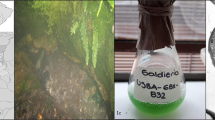Summary
WhenMortierella alpina ATCC 32222 was incubated in a glucose salts medium at 25°C the biomass (17.5 g/l) contained 9.62% arachidonic acid which amounted to 54% (w/w) of total biomass lipids. When the glucose concentration in the medium was varied from 0 to 150 g/l, the percentage of arachidonic acid in biomass and in lipids was highest at a glucose concentration of 30 g/l, but highest yield of arachidonic acid per litre of culture broth was observed at a glucose concentration of 100 g/l. While production of biomass reached a plateau of 17 g/l after a 3-day incubation at 25°C, the percentage of arachidonic acid in lipids and biomass increased dramatically from 3 to 6 days with a concurrent arachidonic acid yield increase from 0.89 to 1.63 g/l. Optimum initial culture pH for arachidonic acid production was in the range 6.0–6.7. By increasing the concentration of the glucose salts medium three-fold, yields of biomass and arachidonic acid were increased to 35.8 g/l and 3.73 g/l, respectively.
Similar content being viewed by others
References
Ahern, T.J., S. Katoh and E. Sada. 1983. Arachidonic acid production by the red algaPorphyridium cruentum. Biotechnol. Bioeng. 25: 1057–1070.
Arao, T., A. Kawaguchi and M. Yamada. 1987. Positional distribution of fatty acids in lipids of the marine diatomPhaeodactylum tricornutum. Phytochemistry 26(9): 2573–2576.
Bajpai, P.K., P. Bajpai and O.P. Ward. 1990. Arachidonic acid production by fungi. Second International Conference on Microbiol Metabolites. Soc. Industr. Microbiol., Sarasota, FL.
Bergstrom, S. and H. Danielsson. 1984. The enzymatic formation of prostaglandin E2 from arachidonic acid, prostaglandins and related factors. Biochim. Biophys. Acta 90: 207–210.
Bligh, E.G. and W.J. Dyer. 1959. A rapid method of total lipid extraction and purification. Can. J. Biochem. Physiol. 37: 911–917.
Block, K. and D. Vance. 1977. Control mechanisms in the synthesis of saturated fatty acids. Annu. Rev. Biochem. 46: 263–298.
Boulton, C.A. and C. Ratledge. 1985. Biosynthesis of fatty acids and lipids. In: Comprehensive Biotechnology, Vol. 1 (Moo-Young, M., ed.), pp. 459–482. Pergamon Press, Oxford.
Chesters, C.G. and J.F. Peberdy. 1965. Nutritional factors in relation to growth and fat synthesis inMortierella vinacea. J. Gen. Microbiol. 41: 127–134.
Chu, F.-L.E. and J.L. Dupuy. 1980. The fatty acid composition of three unicellular algal species used as food sources for larvae of the American oyster (Crassostrea virginica). Lipids 15: 356–364.
Das, U.N., M.E. Begin, Y.S. Huang and D.F. Horrobin. 1987. Polyunsaturated fatty acids augment free radical generation in tumor cellsin vitro. Biochem. Biophys. Res. Commun. 145: 15–24.
Erwin, J. 1973. Comparative biochemistry of fatty acids in eukaryotic microorganisms. In: Lipids and Biomembranes of Eucaryotic Microorganisms (Erwin, J.A., ed.), pp. 41–143, Academic Press, New York, NY.
Erwin, J. and K. Bloch. 1964. Biosynthesis of unsaturated fatty acids in microorganisms—structure and biosynthetic pathways are compared and related to physiological properties of the organisms. Science 143: 1006–1012.
Ferrante, G. and M. Kates. 1983. Pathways for desaturation of oleoyl chains ofCandida lipolytica. Can. J. Biochem. Cell Biol. 61: 1191–1196.
Gellerman, J.L. and K. Schlenk. 1979. Methyl-directed desaturation of arachidonic acid to eicosapentaenoic acid in the fungus,Saprolegnia parasitica. Biochim. Biophys. Acta 573: 23–30.
Hansson, L. and M. Dostalek. 1988. Effect of culture conditions on mycelial growth and production of γ-linolenic acid by the fungusMortierella ramanniana. Appl. Microbiol. Biotechnol. 28: 240–246.
Harris, R.V. and A.T. James. 1965. Linoleic and α-linolenic acid biosynthesis in plant leaves and a green alga. Biochim. Biophys. Acta 106: 456–464.
Holub, B.J. and C.M. Skeaff. 1987. Nutritional regulation of cellular phosphatidylinositol. Meth. Enzymol. 141: 234–244.
Marx, J.L. 1982. The leukotrienes in allergy and inflammation. Science 215: 1380–1383.
Meyer, F. and K. Bloch. 1963. Effect of temperature on the enzymatic synthesis of unsaturated fatty acids byTorulopsis utilis. Biochim. Biophys. Acta 106: 456–464.
Orme, T.W., J. McIntyre, F. Lynen, L. Kühn and E. Schweizer. 1972. Fatty-acid elongation in a mutant ofSaccharomyces cerevisiae deficient in fatty-acid synthase. Eur. J. Biochem. 24: 407–415.
Roggenkamp, R., S. Numa and E. Schweizer. 1980. Fatty acid-requiring mutant ofSaccharomyces cerevisiae defective in acetyl-CoA carboxylase. Proc. Natl. Acad. Sci. USA 77: 1814–1817.
Schweizer, E. 1989. Biosynthesis of fatty acids and related compounds. In: Microbial Lipids (Vol. 2). (Ratledge, C. and S.G. Wilkinson, eds.) pp. 3–50, Academic Press, London.
Shimizu, S., Y. Shinmen, H. Kawashima, K. Akimoto and H. Yamada. 1988. Fungal mycelia as a novel source of eicosapentaenoic acid production at low temperature. Biochem. Biophys. Res. Comm. 150, 335–341.
Shimizu, S., H. Kawashima, K. Akimoto and H. Yamada. 1989. Microbial conversion of an oil containing α-linolenic acid to an oil containing eicosapentaenoic acid. J. Am. Oil. Chem. Soc. 66: 342–347.
Shinmen, Y., H. Yamada and S. Shimizu. 1988. Microbial process for production of dihomo-γ-linolenic acid and eicosapentaenoic acid. European Patent Application 252716.
Simopoulos, A.P. 1989. Summary of the NATO advanced research workshop on dietary ω3 and ω6 fatty acids: Biological effects and nutritional essentiality. J. Nutr. 119: 521–528.
Sinden, K.W. 1987. The production of lipids by fermentation within the EEC. Enz. Microb. Technol. 9, 124 (1987).
Ward, O.P. 1989. Fermentation Biotechnology, Open University Press, Milton Keynes.
Wassef, M.K. 1977. Fungal lipids. In: Advances in Lipid Research. (Paoletti, A. and D. Kritchevsky, eds.) Vol. 15, pp. 159–232, Academic Press, New York, N.Y.
Yamada, H., S. Shimizu and Y. Shinmen. 1987. Production of arachidonic acid byMortierella elongata 1S-5. Agricult. Biol. Chem. 51: 785–790.
Yongmanitchai, W. and O.P. Ward. 1989. Omega-3 fatty acids: Alternative sources of production. Proc. Biochem. 24: 117–125.
Author information
Authors and Affiliations
Rights and permissions
About this article
Cite this article
Bajpai, P.K., Bajpai, P. & Ward, O.P. Production of arachidonic acid byMortierella alpina ATCC 32222. Journal of Industrial Microbiology 8, 179–185 (1991). https://doi.org/10.1007/BF01575851
Received:
Revised:
Accepted:
Issue Date:
DOI: https://doi.org/10.1007/BF01575851




